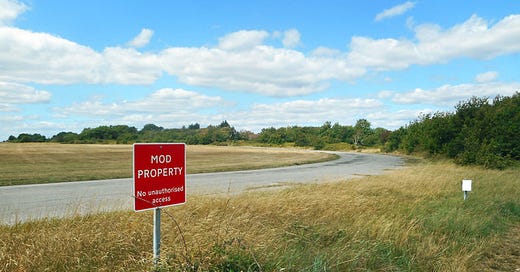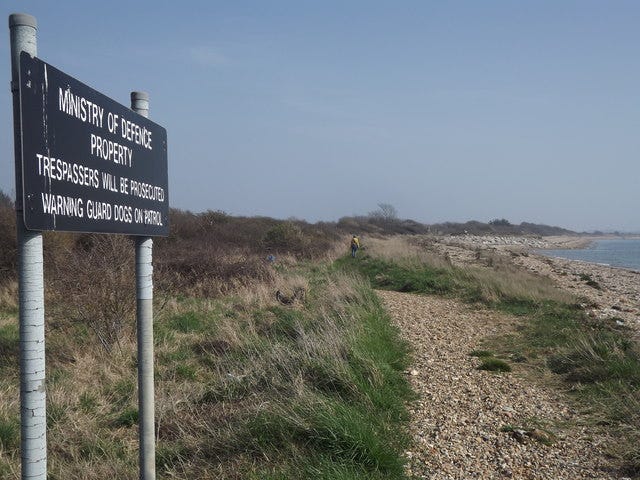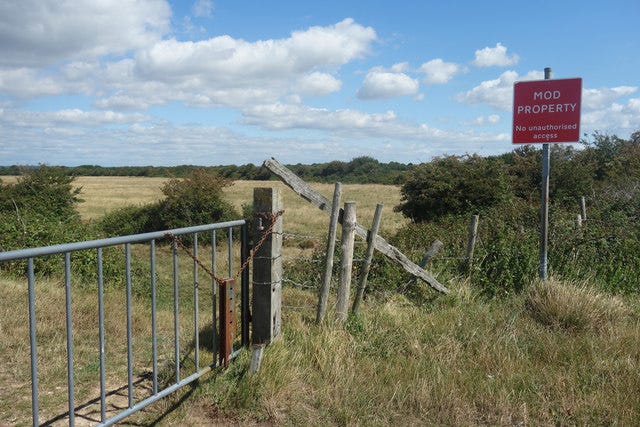Thorney Island. You can go to the right of the sign. But NOT beyond it! (Des Blenkinsopp/geograph)
Two important points to make here.
Firstly, Thorney ‘Island’ isn’t an island and hasn’t been for well over one hundred years, having been reconnected to the West Sussex mainland after the reclamation of 72 hectares of tidal mudflats towards the end of the nineteenth century. So, sadly, any romantic notions you might have of a solitary Robinson Crusoe-like existence amidst the creeks and curlews here will, sadly, have to be abandoned.
Secondly, as picturesque and beguiling as Thorney Island unquestionably is, you can’t just pack up the kids, myriad barking dogs, picnic and your drone into the back of the SUV and tramp around it all day as much of the not-an-island is occupied by the MoD.
That’s right. More men and women with guns. And they’re not afraid to point them at people.
Rest assured, the MOD’s dogs on Thorney Island are bigger and fiercer than yours. Plus their owners have guns! (Colin Smith/geograph)
Thorney, near Chichester in West Sussex, was once home to a remote community of farmers and fisherman who were content to eke a living and get on with their uncomplicated lives from the rich bounty available to them there.
That is until a man from the MoD paid a visit to the island in 1935 and decided that it would make a rather fine base for an RAF station. So out went all the farmers and fishermen whilst in came all fitters and airmen to replace them.
‘Free country’? Not if you have something that the Government wants.
Numerous RAF squadrons made a temporary home for themselves on Thorney, including No.164 Squadron who used Hawker Typhoons against enemy shipping in the area; 236 Squadron who did the same thing, albeit with Bristol Blenheim’s from 1940 to 1941 and 415 Squadron who utilised the Handley Page Hampden as a torpedo-bomber aircraft against enemy convoys and shipyards until 1942.
The runway lights at RAF Thorney Island have outlived their usefulness! (Robin Webster/geograph)
Make no mistake about it, RAF Thorney Island was a very busy place indeed. It’s a lot quieter today of course, but that doesn’t mean the MoD doesn’t value the strategic value of the site any less and the island is currently controlled by the Royal Artillery who have named their part of the site Baker Barracks. They were established in 1986 when the 26th Regiment Royal Artillery moved onto the site which has also been the home to the 47th and 12th Regiment Royal Artillery who have shared Thorney as a home with the 16th Regiment Royal Artillery since 2016.
As you may already have worked out, Artillery Units need a lot of open space around them so they can safely practice the art of firing assorted rockets, mortars and missiles without bringing too much attention (!) to themselves or the work that they do.
So, for that reason, although the general public are permitted to access Thorney Island, said access is strictly restricted to the public footpath that circles the entire site. However, even access to that path can be dependent upon the consent of the MOD so it’s probably a good idea, if you do fancy a wander around Thorney to bring some sort of ID along with you as well as being aware that the peace and quiet of your day may, on occasion, be interrupted by the occasional loud explosion.
But don’t let that put you off. It can be a very pleasant few hours indeed (providing you keep to the path) as Thorney, named after the proliferation of hawthorn bushes on the island, is ecologically special enough to be part of the Chichester Harbour Site of Special Scientific Interest as well as forming part of the Chichester and Langstone Harbours Special Protection Area. It covers around 2,800 hectares in all, much of which are intertidal mudflats, which have long been recognised as a hugely important area for wildlife. Fortunately, the MoD are, surprisingly, considering all the hardware they have there, a fairly benign custodian of the island and tend not to fire their missiles onto the environmentally sensitive areas, although I wouldn’t necessarily say the same thing about you and your car, were you to merrily go on your way to places on the island where you shouldn’t.
A nice spot for a picnic? Gates, chains, barbed wire and signs for the ‘unauthorised’. (Des Blenkinsopp/geograph)
One other thing to bear in mind if you are considering a trip to Thorney Island is that as the footpath that runs around the island is largely on the foreshore, there may be times when it is not accessible due to forces of nature (ie) strong winds and high tides, rather than any obstacles provided by the armed forces in residence. Thus, all in all, it isn’t always the easiest and most accessible place to visit and careful pre-planning in advance should be considered.
…and be aware that whatever you get up to during your visit, that someone, somewhere, will have a pair of binoculars trained on you.
Still, better those, than the sights of a long rage rifle…







